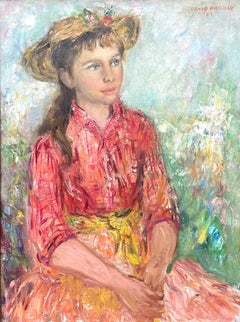David Pallock
1960s Post-Impressionist Portrait Paintings
Canvas, Oil
People Also Browsed
Antique 1890s Fireplaces and Mantels
Breccia Marble
1890s Academic Animal Paintings
Oil
Antique Late 19th Century French Rococo Revival Fireplaces and Mantels
Marble
Antique Early 19th Century French Empire Secretaires
Marble, Ormolu
Antique Late 19th Century French Paintings
Giltwood
1910s Impressionist Interior Paintings
Oil
Antique Mid-19th Century English High Victorian Taxidermy
Other
19th Century American Realist Animal Paintings
Oil
Vintage 1940s Italian Baroque Revival Wall Mirrors
Wood
Antique Mid-18th Century Danish Rococo Cabinets
Bronze
20th Century Impressionist Landscape Paintings
Canvas, Oil
Antique Late 19th Century English Fireplaces and Mantels
Iron
Antique Early 1800s German Religious Items
Silver
1960s Impressionist Figurative Paintings
Canvas, Oil
20th Century Post-Impressionist Figurative Paintings
Canvas, Oil
1860s Academic Portrait Paintings
Canvas, Oil
A Close Look at Post-impressionist Art
In the revolutionary wake of Impressionism, artists like Vincent van Gogh, Georges Seurat, Paul Cézanne and Paul Gauguin advanced the style further while firmly rejecting its limitations. Although the artists now associated with Postimpressionist art did not work as part of a group, they collectively employed an approach to expressing moments in time that was even more abstract than that of the Impressionists, and they shared an interest in moving away from naturalistic depictions to more subjective uses of vivid colors and light in their paintings.
The eighth and final Impressionist exhibition was held in Paris in 1886, and Postimpressionism — also spelled Post-Impressionism — is usually dated between then and 1905. The term “Postimpressionism” was coined by British curator and art critic Roger Fry in 1910 at the “Manet and the Postimpressionists” exhibition in London that connected their practices to the pioneering modernist art of Édouard Manet. Many Postimpressionist artists — most of whom lived in France — utilized thickly applied, vibrant pigments that emphasized the brushstrokes on the canvas.
The Postimpressionist movement’s iconic works of art include van Gogh’s The Starry Night (1889) and Seurat’s A Sunday on La Grande Jatte (1884). Seurat’s approach reflected the experimental spirit of Postimpressionism, as he used Pointillist dots of color that were mixed by the eye of the viewer rather than the hand of the artist. Van Gogh, meanwhile, often based his paintings on observation, yet instilled them with an emotional and personal perspective in which colors and forms did not mirror reality. Alongside Mary Cassatt, Cézanne, Henri Matisse and Gauguin, the Dutch painter was a pupil of Camille Pissarro, the groundbreaking Impressionist artist who boldly organized the first independent painting exhibitions in late-19th-century Paris.
The boundary-expanding work of the Postimpressionist painters, which focused on real-life subject matter and featured a prioritization of geometric forms, would inspire the Nabis, German Expressionism, Cubism and other modern art movements to continue to explore abstraction and challenge expectations for art.
Find a collection of original Postimpressionist paintings, mixed media, prints and other art on 1stDibs.
Finding the Right Portrait-paintings for You
An elegant and sophisticated decorative touch in any living space, portrait paintings have remained popular throughout the years and are widely loved pieces of art for display in many homes today.
Portrait paintings are at least as old as ancient Egypt, where realistic, lifelike depictions of the recently deceased — commonly known as “mummy portraits” — were painted on wooden panels and affixed to mummies as part of the burial tradition.
For centuries, painters have used portraiture as a means of expressing a subject’s nobility, societal status and authority. Portraits were given as gifts in Renaissance Europe, and a portrait artist might have been commissioned to help mark a significant occasion such as a wedding or a promotion to high office. Prior to the advent of photography, which eventually replaced painted portraits as a quicker and more efficient way of capturing a person’s essence, the subject of a portrait had to sit for hours until the painter had finished. And during the 18th century in particular, if an artist commissioned for a portrait struggled with how to adequately memorialize and capture a subject’s likeness, sometimes a portrait painting wasn’t completed for up to a year.
Whether it’s part of the gallery-style approach to your living-room or dining-room walls or merely inspiration as you devise an eye-grabbing color scheme in your home, a portrait painting is a timeless decorative object for any interior. A landscape painting or sculpture might give you the kind of insight into a specific region of the world or a different culture that you can ascertain only through art. Similarly, when you take the time to learn about the subject of a portrait painting that you bring into your home — the sitter’s history, the relationship between the sitter and the artist should one exist, the story of how the portrait came to be — that work can become intensely personal in addition to its place as an object for an art-hungry corner of your apartment or house.
On 1stDibs, visit a vast collection of famous portrait paintings or works by emerging artists. Search by medium to find the right portrait paintings for your home in oil paint, synthetic resin paint and more. Find portrait paintings in a variety of styles, too, including contemporary, Impressionist and Pop art, or search by artist to find unique works created by painters such as Mark Beard, Steve Kaufman and Montse Valdés.
